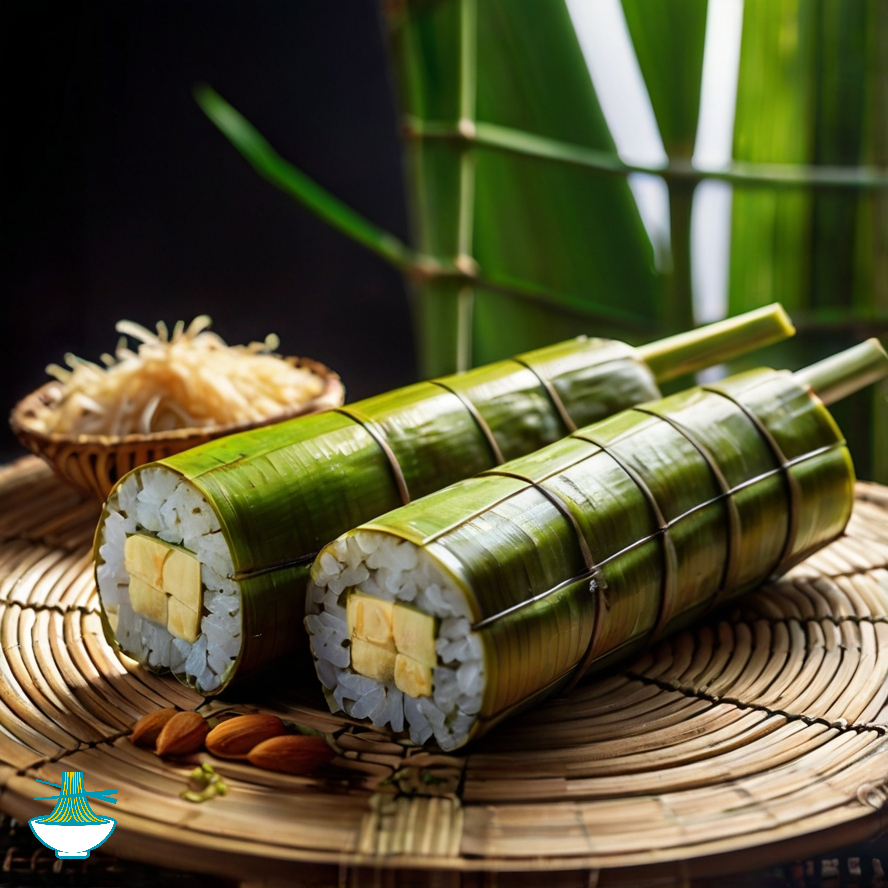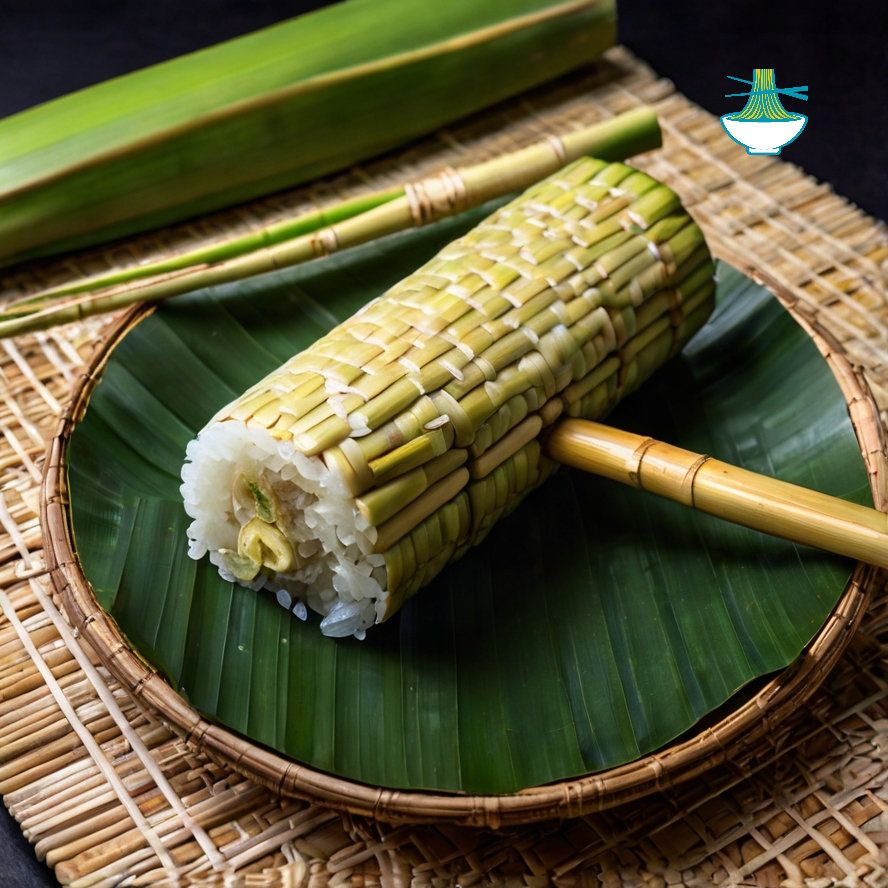Lemang is a traditional Malaysian dish made from glutinous rice cooked in bamboo, often enjoyed during festive occasions like Eid. Not only does this dish provide a unique cultural experience, but it also offers several health benefits due to its wholesome ingredients. The glutinous rice, a primary component of Lemang, is a great source of carbohydrates, offering sustained energy throughout the day. Coconut milk, used in the preparation, is rich in healthy fats like medium-chain triglycerides (MCTs), which support heart health. The pandan leaves, though optional, contain antioxidants that help reduce inflammation and boost overall wellness. Additionally, while Lemang is delicious and energy-boosting, it's important to consume it in moderation due to its calorie density. This dish, with its combination of nutrients, not only satisfies the palate but also supports immune function, digestive health, and even skin vitality.
Ingredients:
- 2 cups of glutinous rice
- 2 cups of coconut milk
- 1-2 pandan leaves (optional)
- 1 tsp salt
- Bamboo sticks or tubes
Preparation Method for Lemang
Soak the Glutinous Rice:
- Start by soaking the glutinous rice in a bowl of water. Leave it to soak for 4-6 hours, or overnight if you prefer. This step ensures the rice absorbs enough moisture to become soft and sticky when cooked.
Rinse and Drain the Rice:
- Once the soaking time is complete, rinse the glutinous rice thoroughly under cold water to remove any excess starch. After rinsing, drain the rice well in a sieve or colander to ensure it isn't too wet when mixed with the coconut milk.
Prepare the Rice Mixture:
- In a large mixing bowl, combine the soaked rice with coconut milk. Add a pinch of salt to enhance the flavor, and if desired, add a couple of pandan leaves for a fragrant, slightly sweet aroma. Gently mix everything together until the rice is evenly coated with the coconut milk.
Stuff the Bamboo Tube:
- Take your bamboo tube (or bamboo sticks) and begin stuffing the rice mixture inside. Fill the bamboo tube about three-quarters full, leaving some space at the top. This allows the rice to expand as it cooks without overflowing.
Seal the Opening:
- To keep the rice from spilling out during cooking, seal the open end of the bamboo tube with banana leaves or foil. The banana leaves not only add a subtle aroma but also help keep the rice moist and flavorful during cooking.
Cook the Lemang:
- There are two methods for cooking Lemang. You can cook the bamboo tube over a charcoal fire for 2-3 hours, rotating it occasionally to ensure even cooking. Alternatively, you can steam the bamboo tube in a large pot or steamer for the same duration. Make sure the rice is cooked through and has a soft, sticky texture.
Cool and Serve:
- After cooking, allow the Lemang to cool for a few minutes. Once it has cooled down slightly, you can cut the bamboo tube open and serve the Lemang. The dish is typically served in slices, showcasing the beautiful glutinous rice inside.
This preparation method ensures that each step is clear and concise, offering a smooth cooking experience that results in perfectly cooked Lemang. Enjoy this delicious Malaysian treat during your next festive occasion!
Variety in Preparation Methods
While traditional Lemang is typically prepared using bamboo tubes, there are several alternative methods for making this dish, especially for those without access to bamboo. Here are some options:
- Using a Regular Pot: If you don't have bamboo tubes, you can steam the rice mixture in a regular pot or steamer. Simply line the bottom of the pot with banana leaves and add the rice mixture on top. Cover and steam for 2-3 hours until fully cooked.
- Baking Method: For those without a steaming setup, you can also bake the rice mixture in an oven-safe dish. Wrap the rice in foil or banana leaves and bake in a preheated oven at 350°F (175°C) for 1.5-2 hours.
For individuals with dietary restrictions, such as those following gluten-free or low-sugar diets, Lemang can be easily adjusted. Here's how:
- Gluten-Free Lemang: The ingredients in Lemang (glutinous rice, coconut milk, pandan leaves, etc.) are naturally gluten-free. Just be sure to check the labels on any processed products, such as coconut milk, to ensure they do not contain gluten.
- Low-Sugar Lemang: To make Lemang lower in sugar, consider reducing the amount of coconut milk or opting for unsweetened coconut milk. You can also substitute the salt with a sodium-free alternative if you prefer to control your sodium intake.
Tips for Serving Lemang
Lemang is typically enjoyed as a main dish during festive occasions like Eid, but it can also be served alongside a variety of other dishes. Here are some tips for serving Lemang:
- Serve with Curries: Lemang pairs beautifully with savory curries such as chicken curry or beef rendang. The rich, creamy texture of the coconut milk in the Lemang complements the spiciness of the curry.
- Accompaniments: Try serving Lemang with a side of pickled vegetables (achar) for a tangy contrast, or with a fresh salad to balance the dish's richness.
- Add Spices: If you prefer a more flavorful Lemang, you can add spices like cardamom, cinnamon, or nutmeg to the rice mixture. These spices will infuse the rice with warmth and depth.
Frequently Asked Questions
What is Lemang?
- Lemang is a traditional Malaysian dish made from glutinous rice cooked inside a bamboo tube, typically enjoyed during festive occasions like Eid. The rice is mixed with coconut milk, salt, and optionally pandan leaves to enhance its flavor.
Can Lemang be made without pandan leaves?
- Yes, pandan leaves are optional. They are primarily used for their aromatic properties, adding a slight sweetness and fragrance to the dish, but they are not essential for preparing Lemang.
How long does Lemang need to cook?
- Lemang requires about 2-3 hours of cooking, either over a charcoal fire or in a steaming pot. Make sure to rotate the bamboo tube occasionally to ensure even cooking.
Can Lemang be made in a healthier way?
- Yes, you can make Lemang healthier by reducing the amount of coconut milk or using a lighter, unsweetened coconut milk option. This can help lower the overall calorie count while still maintaining the dish's rich texture.
What are the health benefits of Lemang's rice?
- The glutinous rice in Lemang is rich in carbohydrates, providing long-lasting energy. It also contains small amounts of thiamine, which supports the metabolism and nervous system.
Can Lemang be stored?
- Yes, Lemang can be stored in the refrigerator for up to 3 days. To reheat, simply steam or microwave it until hot. If you want to store it for longer, it can be frozen for up to a month.

Nutritional values and benefits
Glutinous rice (2 cups)
- Calories: 400
- Carbohydrates: 88g
- Protein: 7g
- Fat: 1g
- Sodium: 5mg
- Vitamins:
- Thiamine (Vitamin B1): 0.3mg
Nutritional Benefit: Glutinous rice provides an excellent source of energy, offering a high carbohydrate content. It’s also rich in essential vitamins like Thiamine, which aids in metabolism and nervous system function.
Coconut milk (2 cups)
- Calories: 400
- Carbohydrates: 8g
- Protein: 4g
- Fat: 40g
- Sodium: 50mg
- Vitamins:
- Vitamin C: 4mg
- Vitamin E: 2mg
Nutritional Benefit: Coconut milk is rich in healthy fats, particularly medium-chain triglycerides (MCTs), which may promote heart health. It also contains small amounts of vitamins that support the immune system and skin health.
Pandan leaves (optional)
- Calories: 5 (per leaf)
- Carbohydrates: 1g
- Protein: 0g
- Fat: 0g
Nutritional Benefit: Pandan leaves are used mainly for their aromatic properties, adding flavor without significantly affecting the nutritional value. They are rich in antioxidants, which can help reduce inflammation.
Banana leaves or foil (for wrapping)
- Calories: Negligible
Nutritional Benefit: Banana leaves are used for wrapping the Lemang and do not contribute significant nutrients. However, they provide a natural way to enhance flavor and texture.
Additional Information on Ingredient Benefits
In addition to the health benefits of glutinous rice, coconut milk, and pandan leaves, here’s a deeper dive into the additional ingredients used in Lemang:
- Banana Leaves: While primarily used for wrapping the Lemang, banana leaves contribute a subtle aroma and enhance the texture of the rice. They are also rich in antioxidants that help fight oxidative stress and inflammation.
- Coconut Milk: Apart from being rich in healthy fats like MCTs, coconut milk also supports digestive health by aiding in nutrient absorption. It is also known for its antimicrobial properties, helping the body fight off harmful bacteria.
This combination of ingredients in Lemang results in a dish that is not only flavorful but also provides significant energy, healthy fats, and antioxidants. It is best enjoyed as part of a balanced diet, especially during special occasions.


Comments